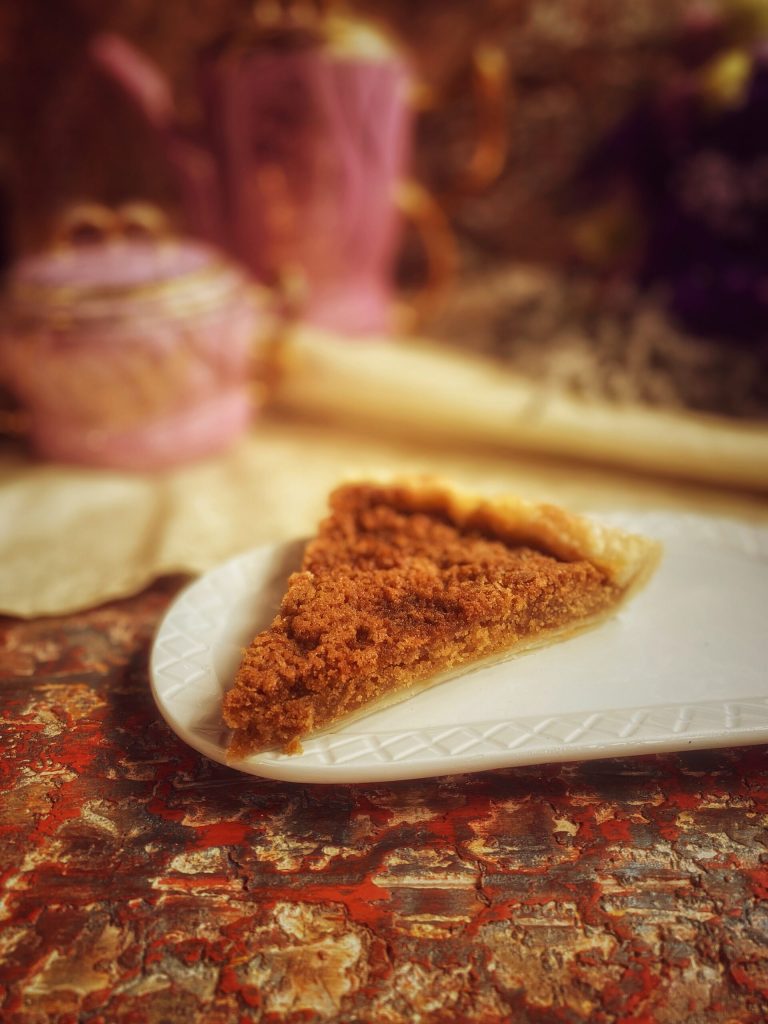The shoofly pie or shoo-fly pie, also known as melassich riwwelboi and melassichriwwelkuche, is a type of American pie made with molasses associated with Pennsylvania Dutch cuisine.
The main ingredients of the filling are: molasses, brown sugar, and water.
Although it was a staple food of Moravian, Mennonite, and Amish cuisine, there is little evidence regarding its origins, and most of the folk tales concerning the pie are apocryphal, including the legend that the name derives from flies being drawn to it.
The name shoo-fly was borrowed from a brand of molasses that was popular in parts of the United States during the late 19th century.
Possibly related to the Jenny Lind cake (a soft gingerbread cake), it may have originated among the Pennsylvania Dutch in 1880 as a crumb cake made with molasses and is sometimes called molasses crumb pie.
Traditionally it was not served as a dessert pie, but rather as a breakfast food with hot coffee.
The modern form of the shoofly pie as a crumb cake served in a pie crust was a post-Civil War innovation when cast-iron pots and stoves made pie crust easier to prepare for home cooks.
It is available in two different versions: wet-bottom and dry-bottom.
The dry-bottom version (the one that follows) is baked until fully set and results in a more cake-like texture.
The wet-bottom version is set like a cake on top where it is mixed with a crumble, but the bottom itself has a stickier custard-like texture.

- Difficulty: Easy
- Cost: Economical
- Preparation time: 10 Minutes
- Portions: 4People
- Cooking methods: Oven
- Cuisine: American
- Seasonality: Autumn, Winter
Ingredients
- 1 package pie crust
- 1 1/2 cups flour
- 1/3 cup brown sugar
- to taste ground cinnamon
- to taste nutmeg
- 1/2 cup butter
- 3/8 cup molasses
- 1/2 teaspoon baking powder
- to taste salt
Steps
For the Pie crust recipe, follow the recipe. Line a 12-inch pie pan.
For the filling: mix the flour with the brown sugar, add the cinnamon, nutmeg, salt, and butter in pieces. Mix to create a sandy mixture.
Add the molasses, 3/8 cup of boiling water, and baking powder.
Pour the mixture into the pie crust.
Bake in the oven at 356°F for 20 minutes.

FAQ
What is the history of Shoofly pie?
Shoofly pie originated as a crustless molasses cake called Centennial Cake in 1876, to celebrate the centennial of the signing of the Declaration of Independence in Philadelphia.
There is no evidence it was made before the American Civil War.
In 1880, home bakers added a crust to make it easier to eat along with a cup of coffee in the morning, without plates and forks.
Because shoofly pie traditionally contains molasses but no eggs, historians conclude that it was typically baked during the winter when hens laid fewer eggs and molasses could be kept in the cold season without fear of fermenting.
The use of baking powder places its invention firmly after the Civil War and in the 1870s when Pennsylvania Dutch bakers began to use it.What is the origin of the name Shoofly pie?
The modern name Shoofly pie comes from a particular brand of molasses from Philadelphia, Shoo-fly Molasses.
The brand “Shoo-fly Molasses” is named after a popular circus animal that toured Pennsylvania in the 19th century, “Shoo-fly the Boxing Mule”.
The mule, in turn, might have been named after a song that became popular half a century earlier: “Shoo Fly, Don’t Bother Me”.
“Shoo-fly pie” was used in 1880, but its first appearance in print was after World War I.
In the Pennsylvania Dutch language, shoo-fly pie is called Melassich Riwwelboi or Melassichriwwelkuche (molasses crumb cake).
Before its modern name became popular during the 20th century, it was called crumb pie or soda rivvel cake (the rivvel are lumps of food).What other pies are similar to Shoofly pie?
The Montgomery pie is similar to a shoofly pie, except lemon juice is used in the bottom layer.
The Treacle tart is a pie with a filling based on light molasses.
Precursors include the Jenny Lind cake, a type of gingerbread cake named after the famous Swedish opera star, Jenny Lind, after her American tour in the 1850s.

